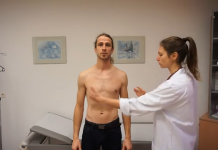The smart mirror “MirReha” addresses patients with Parkinson’s disease, they use the mirror to perform exercises at home in addition to speech therapy.
Background:
The Parkinson’s disease is affecting more than six million people worldwide (Arjunan & Kumar, 2022, p. 32). Parkinson’s patients suffer from a wide range of symptoms like motor and speech impairments (Arjunan & Kumar, 2022, p. 6f). Digital interventions could extend the current treatment and improve the therapeutic approach especially in the field of speech therapy. Currently there is no existing technology that allows the patient to perform exercises at home in front of a mirror while being instructed (Frieg et al., 2017). Therefore, a smart mirror could be used to display exercises and to improve the therapy compliance (Besserer et al., 2016). Beneficial use cases for Parkinson’s patients displayed on a smart mirror could be motivational quotes and weekly goals, mimic exercises, training articulatory movements, tongue training, training of speech loudness and training for an increased swallowing frequency (Deuschl & Nebel, 2017; Van Leer & Connor, 2015). In addition, patients could benefit from instructions about dental care, postural improvement and breathing exercises (Barbe et al., 2017; Drissi et al., 2020; Kwok et al., 2017).
Project idea:
The aim of the project „MirReha” is to develop a smart mirror that supports speech therapy for patients with Parkinson’s disease in the home setting. The smart mirror provides exercises, that extend the conventional speech therapy with a speech therapist. These exercises can be performed in front of the mirror in the own bathroom while being instructed by the mirror. The exercises and instructions of the mirror tend to improve the loudness of speech and the mimic of the patients. In addition, the smart mirror can enhance the motivation to perform the exercises and increase the patients’ compliance. The visual and auditive feedback of the mirror for the performed tasks can also improve the self-awareness of the own symptoms. In the project a prototype with different hardware components, like a computer display, a spy-mirror-glass and a software including a user-friendly interface will be developed. Further components like a camera will be used to extend the functionality of the mirror. After the development of the smart mirror the technology will be evaluated by experts of the field (e.g speech therapists, head nurses).
Evaluation:
The aim of the evaluation was to find out how healthcare professionals evaluate the usability of the smart mirror prototype “MirReha”.
A total of five healthcare professionals tested the smart mirror for ten minutes. The participants then completed an adapted usability questionnaire.
The evaluation shows that “MirReha” has a good usability and that users can operate it well. With a few exceptions, the user interface of the smart mirror was also rated as user-friendly. Furthermore, the hypothesis “The smart mirror prototype is rated as a user-friendly tool, based on the System Usability Scale, by the participants” could be confirmed because the mirror can be classified as user-friendly.
In subsequent projects, the feedback from the participants will be implemented in a revised version of the prototype. The next step will be to evaluate the revised prototype with the target group (Parkinson’s patients) to get specific feedback on the general usability, specific tasks and functionalities of the prototype.
A project at the St. Pölten University of Applied Sciences Master Program Digital Healthcare Project coach: FH-Prof. Andreas Jakl, MSc
Literature:
- Arjunan, S. P., & Kumar, D. K. (Eds.). (2022). Techniques for Assessment of Parkinsonism for Diagnosis and Rehabilitation. Springer Singapore. doi.org/10.1007/978-981-16-3056-9
- Barbe, A. G., Bock, N., Derman, S. H. M., Felsch, M., Timmermann, L., & Noack, M. J. (2017). Self-assessment of oral health, dental health care and oral health-related quality of life among Parkinson’s disease patients. Gerodontology, 34(1), 135–143. doi.org/10.1111/ger.12237
- Besserer, D., Bäurle, J., Nikic, A., Honold, F., Schüssel, F., & Weber, M. (2016). Fitmirror: A smart mirror for positive affect in everyday user morning routines. Proceedings of the Workshop on Multimodal Analyses Enabling Artificial Agents in Human-Machine Interaction, 48–55. doi.org/10.1145/3011263.3011265
- Deuschl, G., & Nebel, A. (2017). Dysarthrie und Dysphagie bei Morbus Parkinson (2nd ed.). Georg Thieme Verlag KG.
- Drissi, N., Ouhbi, S., Janati Idrissi, M. A., & Ghogho, M. (2020). An analysis on self-management and treatment-related functionality and characteristics of highly rated anxiety apps. International Journal of Medical Informatics, 141, 104243. doi.org/10.1016/j.ijmedinf.2020.104243
- Frieg, H., Mühlhaus, J., Ritterfeld, U., & Bilda, K. (2017). Assistive Technologien in der Dysarthrietherapie. Schulz-Kirchner Verlag. doi.org/10.2443/skv-s-2017-53020170302
- Kwok, J. Y. Y., Kwan, J. C. Y., Auyeung, M., Mok, V. C. T., & Chan, H. Y. L. (2017). The effects of yoga versus stretching and resistance training exercises on psychological distress for people with mild-to-moderate Parkinson’s disease: Study prxotocol for a randomized controlled trial. Trials, 18(1), 509. doi.org/10.1186/s13063-017-2223-x
- Van Leer, E., & Connor, N. P. (2015). Predicting and Influencing Voice Therapy Adherence Using Social–Cognitive Factors and Mobile Video. American Journal of Speech-Language Pathology, 24(2), 164–176. doi.org/10.1044/2015_AJSLP-12-0123



